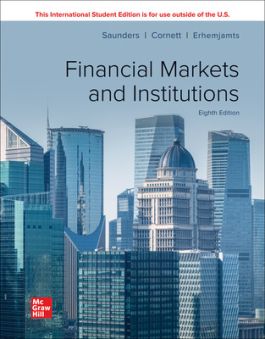Financial Markets and Institutions ISE
El envío se realiza por medio de paquetería FEDEX.
- Considere que el tiempo de envío toma de 7 a 10 días, por favor ingrese su dirección lo más exacto posible para evitar demoras por parte de la mensajería.
- Para pagos en BBVA, transferencias interbancarias o tiendas de autoservicio, NO REDONDEAR el monto.
Part 1: INTRODUCTION AND OVERVIEW OF FINANCIAL MARKETS
Chapter 1: Introduction
Chapter 2: Determinants of Interest Rates
Chapter 3: Interest Rates and Security Valuation
Chapter 4: The Federal Reserve System, Monetary Policy, and InterestRates
Part 2: SECURITIES MARKETS
Chapter 5: Money Markets
Chapter 6: Bond Markets
Chapter 7: Mortgage Markets
Chapter 8: Stock Markets
Chapter 9: Foreign Exchange Markets
Chapter 10: Derivative Securities Markets
Part 3: COMMERCIAL BANKS
Chapter 11: Commercial Banks
Chapter 12: Commercial Banks’ Financial Statements and Analysis
Chapter 13: Regulation of Commercial Banks
Part 4: OTHER FINANCIAL INSTITUTIONS
Chapter 14: Other Lending Institutions
Chapter 15: Insurance Companies
Chapter 16: Securities Firms and Investment Banks
Chapter 17: Investment Companies
Chapter 18: Pension Funds
Chapter 19: Fintech Companies
Part 5: RISK MANAGEMENT IN FINANCIAL INSTITUTIONS
Chapter 20: Types of Risks Incurred by Financial Institutions
Chapter 21: Managing Credit Risk on the Balance Sheet
Chapter 22: Managing Liquidity Risk on the Balance Sheet
Chapter 23: Managing Interest Rate Risk and Insolvency Risk on theBalance Sheet
Chapter 24: Managing Risk off the Balance Sheet with DerivativeSecurities
Chapter 25: Managing Risk off the Balance Sheet with Loan Sales andSecuritization
Since the author team's focus is on return and risk and the sources of that return and risk in domestic and foreign financial markets and institutions, this text relates ways in which a modern financial manager, saver, and investor can expand return with a managed level of risk to achieve the best, or most favorable, return–risk outcome.

